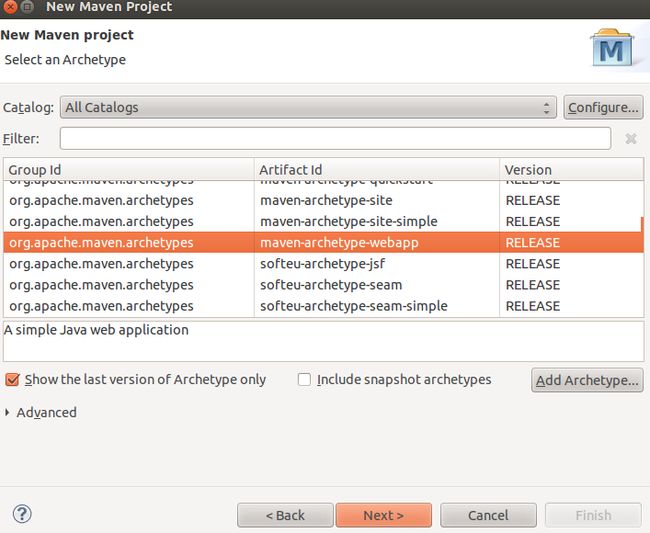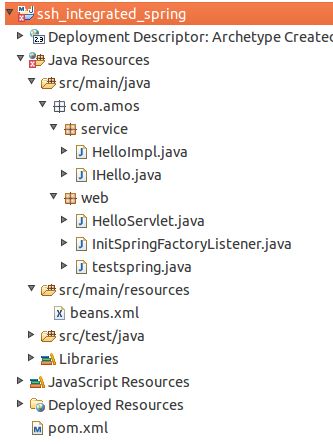一.需求
使用spring去管理web项目,是目前非常流行的一种思路,本文将介绍使用maven+spring 4.0.2 来构建一个简单的web项目.
二.实现
1.新建一个maven项目,如下图所示:
这里因为是构建web项目,所以,选择的是webapp.
项目的架构图:
2.在pom.xml中添加所依赖的jar包,如下所示:
<project xmlns="http://maven.apache.org/POM/4.0.0" xmlns:xsi="http://www.w3.org/2001/XMLSchema-instance" xsi:schemaLocation="http://maven.apache.org/POM/4.0.0 http://maven.apache.org/maven-v4_0_0.xsd"> <modelVersion>4.0.0modelVersion> <groupId>com.amosgroupId> <artifactId>ssh_integratedartifactId> <packaging>warpackaging> <version>0.0.1-SNAPSHOTversion> <name>ssh_integrated Maven Webappname> <url>http://maven.apache.orgurl> <dependencies> <dependency> <groupId>org.springframeworkgroupId> <artifactId>spring-webartifactId> <version>4.0.2.RELEASEversion> dependency> <dependency> <groupId>junitgroupId> <artifactId>junitartifactId> <version>3.8.1version> <scope>testscope> dependency> <dependency> <groupId>org.springframeworkgroupId> <artifactId>spring-contextartifactId> <version>4.0.2.RELEASEversion> dependency> dependencies> <build> <finalName>ssh_integrated_springfinalName> build> project>
3.新建一个接口com.amos.service.IHello.java,并实现接口.
package com.amos.service; public interface IHello { public String sayHi(); }
com.amos.service.HelloImpl.java
package com.amos.service; import java.util.Date; public class HelloImpl implements IHello{ private String msg; public void setMsg(String msg) { this.msg = msg; } public String sayHi() { return "当前时间:"+new Date()+" msg:"+msg; } }
4.新建一个Servlet,并实现此Servlet
com.amos.web.HelloServlet
package com.amos.web; import java.io.IOException; import javax.servlet.ServletException; import javax.servlet.annotation.WebServlet; import javax.servlet.http.HttpServlet; import javax.servlet.http.HttpServletRequest; import javax.servlet.http.HttpServletResponse; import org.springframework.context.ApplicationContext; import org.springframework.web.context.support.WebApplicationContextUtils; import com.amos.service.IHello; @WebServlet(name="HelloServlet",urlPatterns={"/hello"}) public class HelloServlet extends HttpServlet { private static final long serialVersionUID = 2801654413247618244L; private IHello hello; protected void doGet(HttpServletRequest req, HttpServletResponse resp) throws ServletException, IOException { //方法1,使用传统方式去加载beans.xml,每次请求时加载 //ApplicationContext applicationContext = new ClassPathXmlApplicationContext("beans.xml"); //方法2,使用监听器的方式加载beans.xml,在一启动的时候就加载监听器,避免多次加载,提高效率 //ApplicationContext applicationContext = (ApplicationContext) this.getServletContext().getAttribute("SpringApplicationContext"); //方法3,使用spring自带的监听器去加载beans.xml //ApplicationContext applicationContext = (ApplicationContext) this.getServletContext().getAttribute(WebApplicationContext.ROOT_WEB_APPLICATION_CONTEXT_ATTRIBUTE); //使用webapplicationcontextutils这个工具类可以很方便的获取ApplicationContext,只需要传入servletContext ApplicationContext applicationContext = WebApplicationContextUtils.getRequiredWebApplicationContext(this.getServletContext()); hello = applicationContext.getBean(IHello.class); String sayHi = hello.sayHi(); System.err.println("sayHi:" + sayHi); resp.setContentType("text/html;charset=utf-8"); resp.getWriter().write("" + sayHi + "
"); } }
注:这里要注意的是实现spring管理Bean的三种方式.
第一种:最传统的方式,同时也是效率最低的一种,因为,每次发一个请求都要重新加载一次,而且对于不同的Servlet的要每个都去加载,会大大降低效率.
第二种:使用监听器来实现加载beans.xml,每次项目启动的时候加载一次就可以了.这样大提高了效率.
com.amos.web.InitSpringFactoryListener.java
package com.amos.web; import javax.servlet.ServletContextEvent; import javax.servlet.ServletContextListener; import org.springframework.context.ApplicationContext; import org.springframework.context.support.ClassPathXmlApplicationContext; public class InitSpringFactoryListener implements ServletContextListener { public InitSpringFactoryListener() { } public void contextInitialized(ServletContextEvent arg0) { //这里将加载beans.xml加载到内存中,放到servletcontext中,名称可以随便取,这里取为SpringApplicationContext, ApplicationContext applicationContext = new ClassPathXmlApplicationContext("beans.xml"); arg0.getServletContext().setAttribute("SpringApplicationContext", applicationContext); } public void contextDestroyed(ServletContextEvent arg0) { } }
同时,web.xml中要定义一个listener属性.
第三种:针对第二种方法,其实spring中已经封装好了一种监听器,人工去配置即可,原理和第二种方法一致.
只需要在web.xml中加入如下代码即可.
<listener>
<listener-class>org.springframework.web.context.ContextLoaderListenerlistener-class>
listener>
但运行进会报如下错误:
org.springframework.beans.factory.BeanDefinitionStoreException: IOException parsing XML document from ServletContext resource [/WEB-INF/applicationContext.xml]; nested exception is java.io.FileNotFoundException: Could not open ServletContext resource [/WEB-INF/applicationContext.xml]
at org.springframework.beans.factory.xml.XmlBeanDefinitionReader.loadBeanDefinitions(XmlBeanDefinitionReader.java:343)
at org.springframework.beans.factory.xml.XmlBeanDefinitionReader.loadBeanDefinitions(XmlBeanDefinitionReader.java:303)
at org.springframework.beans.factory.support.AbstractBeanDefinitionReader.loadBeanDefinitions(AbstractBeanDefinitionReader.java:180)
at org.springframework.beans.factory.support.AbstractBeanDefinitionReader.loadBeanDefinitions(AbstractBeanDefinitionReader.java:216)
at org.springframework.beans.factory.support.AbstractBeanDefinitionReader.loadBeanDefinitions(AbstractBeanDefinitionReader.java:187)
at org.springframework.web.context.support.XmlWebApplicationContext.loadBeanDefinitions(XmlWebApplicationContext.java:125)
at org.springframework.web.context.support.XmlWebApplicationContext.loadBeanDefinitions(XmlWebApplicationContext.java:94)
at org.springframework.context.support.AbstractRefreshableApplicationContext.refreshBeanFactory(AbstractRefreshableApplicationContext.java:129)
at org.springframework.context.support.AbstractApplicationContext.obtainFreshBeanFactory(AbstractApplicationContext.java:540)
........
Caused by: java.io.FileNotFoundException: Could not open ServletContext resource [/WEB-INF/applicationContext.xml]
at org.springframework.web.context.support.ServletContextResource.getInputStream(ServletContextResource.java:141)
at org.springframework.beans.factory.xml.XmlBeanDefinitionReader.loadBeanDefinitions(XmlBeanDefinitionReader.java:329)
... 22 more
说找不到applicationContext.xml文件,那么如何解决这个问题呢?
他说找不到,那就在WIB-INF目录下建一个即可.
然后引入自定义的beans.xml即可.
xml version="1.0" encoding="UTF-8"?>
<beans xmlns="http://www.springframework.org/schema/beans"
xmlns:xsi="http://www.w3.org/2001/XMLSchema-instance" xmlns:context="http://www.springframework.org/schema/context"
xmlns:tx="http://www.springframework.org/schema/tx" xmlns:aop="http://www.springframework.org/schema/aop"
xsi:schemaLocation="http://www.springframework.org/schema/beans
http://www.springframework.org/schema/beans/spring-beans-4.0.xsd
http://www.springframework.org/schema/context
http://www.springframework.org/schema/context/spring-context-4.0.xsd
http://www.springframework.org/schema/tx
http://www.springframework.org/schema/tx/spring-tx-4.0.xsd
http://www.springframework.org/schema/aop
http://www.springframework.org/schema/aop/spring-aop-4.0.xsd
">
<import resource="classpath:beans.xml"/>
beans>
这个时候问题解决.
这里HelloSerlvet中如何获取对应的ApplicationContext呢?
//方法3,使用spring自带的监听器去加载beans.xml //ApplicationContext applicationContext = (ApplicationContext) this.getServletContext().getAttribute(WebApplicationContext.ROOT_WEB_APPLICATION_CONTEXT_ATTRIBUTE);
这个是需要查看源码才能发现其属性名称,所以比较麻烦.这里还有一种较简便的方法,如下所示:
//使用webapplicationcontextutils这个工具类可以很方便的获取ApplicationContext,只需要传入servletContext ApplicationContext applicationContext = WebApplicationContextUtils.getRequiredWebApplicationContext(this.getServletContext());
第三种方法,基本上配置完毕,但还会感觉很不爽,因为还要新建一个applicationContext.xml去专门import bean.xml,是相当讨厌的.
其实还可以在web.xml中配置自定义的xml文件名称,如下所示:
<context-param>
<param-name>contextConfigLocationparam-name>
<param-value>classpath:beans.xmlparam-value>
context-param>
org.springframework.web.context.ContextLoaderListener中有这样一段说明:
<p>Processes a {@link #CONFIG_LOCATION_PARAM "contextConfigLocation"} * context-param and passes its value to the context instance, parsing it into * potentially multiple file paths which can be separated by any number of * commas and spaces, e.g. "WEB-INF/applicationContext1.xml, * WEB-INF/applicationContext2.xml". Ant-style path patterns are supported as well, * e.g. "WEB-INF/*Context.xml,WEB-INF/spring*.xml" or "WEB-INF/**/*Context.xml". * If not explicitly specified, the context implementation is supposed to use a * default location (with XmlWebApplicationContext: "/WEB-INF/applicationContext.xml"). *
可以自定义spring默认加载的xml文件的名称,可以以逗号和空格进行分隔,也可以使用Ant类型的去标记.xml如,WEB-INF/spring*.xml
否则默认的加载的就是applicationContext.xml.
可以在web.xml中进行配置其参数.
所以,最终的web.xml如下:
DOCTYPE web-app PUBLIC
"-//Sun Microsystems, Inc.//DTD Web Application 2.3//EN"
"http://java.sun.com/dtd/web-app_2_3.dtd" >
<web-app>
<display-name>Archetype Created Web Applicationdisplay-name>
<context-param>
<param-name>contextConfigLocationparam-name>
<param-value>classpath:beans.xmlparam-value>
context-param>
<listener>
<listener-class>org.springframework.web.context.ContextLoaderListenerlistener-class>
listener>
web-app>
5.运行效果
6.本文源码
https://github.com/amosli/ssh_integrated_spring


